Movement Characteristics of Droplet Deposition in Flat Spray Nozzle for Agricultural UAVs
Abstract
1. Introduction
2. Materials and Methods
2.1. Instruments and Equipment
2.2. Measurement of Droplet Size
2.3. Measurement of Droplet Deposition Velocity Field
2.4. Data Processing
2.4.1. Processing of Droplet Diameter
2.4.2. Visualization Processing of Droplet Deposition Movement
3. Results
3.1. The Distribution of Droplet Velocity Field
3.2. The Distribution of Droplet Quantities at Different Speeds
4. Discussion
5. Conclusions
- (1)
- The droplet deposition velocities and the region of high-speed droplet distribution increase with the increase of rotor speeds, spray pressures, and nozzle sizes. As the rotor speed increases from 0 r/min to 1800 r/min, the average increases in maximum droplet deposition velocity for three different nozzle diameters are 33.26%, 19.02%, and 7.62%, respectively.
- (2)
- The rotor flow field significantly increases the number of droplets with high deposition velocities. With increasing rotor speed, the quantity of high-speed droplets increases, and the distribution range of droplets with different deposition velocities narrows. Droplets with more dispersed velocities become more concentrated.
- (3)
- Rotor speed notably affects both the droplet deposition velocity and the rate of velocity decay. At rotor speeds of 0, 1000, 1500, and 1800 r/min, the decay rates of average droplet velocities are 36.72%, 20.00%, 15.47%, and 13.21%, respectively. This indicates that the rotor flow field slows down the reduction in droplet deposition velocity, enabling droplets to deposit rapidly in the target area at higher speeds, thereby reducing drifting risks.
Author Contributions
Funding
Data Availability Statement
Acknowledgments
Conflicts of Interest
References
- Tudi, M.; Daniel Ruan, H.; Wang, L.; Lyu, J.; Sadler, R.; Connell, D.; Chu, C.; Phung, D.T. Agriculture Development, Pesticide Application and Its Impact on the Environment. Int. J. Environ. Res. Public Health 2021, 18, 1112. [Google Scholar] [CrossRef] [PubMed]
- Pan, X.; Dong, F.; Liu, X.; Xu, J.; Wu, X.; Zheng, Y. Development and Application of Pesticide in China in Past 70 Years. Mod. Agrochem. 2020, 19, 1–5+23, (In Chinese with English Abstract). [Google Scholar]
- Otto, S.; Loddo, D.; Baldoin, C.; Zanin, G. Spray Drift Reduction Techniques for Vineyards in Fragmented Landscapes. J. Environ. Manag. 2015, 162, 290–298. [Google Scholar] [CrossRef] [PubMed]
- Chen, P.; Douzals, J.P.; Lan, Y.; Cotteux, E.; Delpuech, X.; Pouxviel, G.; Zhan, Y. Characteristics of Unmanned Aerial Spraying Systems and Related Spray Drift: A Review. Front. Plant Sci. 2022, 13, 870956. [Google Scholar] [CrossRef]
- Aktar, W.; Paramasivam, M.; Sengupta, D.; Purkait, S.; Ganguly, M.; Banerjee, S. Impact Assessment of Pesticide Residues in Fish of Ganga River around Kolkata in West Bengal. Environ. Monit. Assess. 2009, 157, 97–104. [Google Scholar] [CrossRef]
- Syafrudin, M.; Kristanti, R.A.; Yuniarto, A.; Hadibarata, T.; Rhee, J.; Al-onazi, W.A.; Algarni, T.S.; Almarri, A.H.; Al-Mohaimeed, A.M. Pesticides in Drinking Water—A Review. Int. J. Environ. Res. Public Health 2021, 18, 468. [Google Scholar] [CrossRef]
- Shi, Q.; Liu, D.; Mao, H.; Shen, B.; Li, M. Wind-Induced Response of Rice under the Action of the Downwash Flow Field of a Multi-Rotor UAV. Biosyst. Eng. 2021, 203, 60–69. [Google Scholar] [CrossRef]
- Li, J.; Guo, S.; Yao, W.; Zhan, Y.; Li, Y. Distribution Characteristics of Droplet Size in Rice Field and Wind Tunnel Simulation Test under Airflow Operation. Trans. Chin. Soc. Agric. Mach. 2019, 50, 148–156, (In Chinese with English Abstract). [Google Scholar]
- Zhu, Y.; Guo, Q.; Tang, Y.; Zhu, X.; He, Y.; Huang, H.; Luo, S. CFD Simulation and Measurement of the Downwash Airflow of a Quadrotor Plant Protection UAV during Operation. Comput. Electron. Agric. 2022, 201, 107286. [Google Scholar] [CrossRef]
- Yang, S.; Xu, P.; Jiang, S.; Zheng, Y. Downwash Characteristics and Analysis from a Six-rotor Unmanned Aerial Vehicle Configured for Plant Protection. Pest Manag. Sci. 2022, 78, 1707–1720. [Google Scholar] [CrossRef]
- Zhan, Y.; Chen, P.; Xu, W.; Chen, S.; Han, Y.; Lan, Y.; Wang, G. Influence of the Downwash Airflow Distribution Characteristics of a Plant Protection UAV on Spray Deposit Distribution. Biosyst. Eng. 2022, 216, 32–45. [Google Scholar] [CrossRef]
- Tang, Y.; Fu, Y.; Guo, Q.; Huang, H.; Tan, Z.; Luo, S. Numerical Simulation of the Spatial and Temporal Distributions of the Downwash Airflow and Spray Field of a Co-Axial Eight-Rotor Plant Protection UAV in Hover. Comput. Electron. Agric. 2023, 206, 107634. [Google Scholar] [CrossRef]
- Liu, Z.; Gao, R.; Zhao, Y.; Wu, H.; Liang, Y.; Liang, K.; Liu, D.; Huang, T.; Xie, S.; Lv, J.; et al. Study on the Characteristics of Downwash Field Range and Consistency of Spray Deposition of Agricultural UAVs. Agriculture 2024, 14, 931. [Google Scholar] [CrossRef]
- Guo, S.; Li, J.; Yao, W.; Hu, X.; Wei, X.; Long, B.; Wu, H.; Li, H. Optimization of the Factors Affecting Droplet Deposition in Rice Fields by Rotary Unmanned Aerial Vehicles (UAVs). Precis. Agric. 2021, 22, 1918–1935. [Google Scholar] [CrossRef]
- Kharim, M.N.A.; Wayayok, A.; Mohamed Shariff, A.R.; Abdullah, A.F.; Husin, E.M. Droplet Deposition Density of Organic Liquid Fertilizer at Low Altitude UAV Aerial Spraying in Rice Cultivation. Comput. Electron. Agric. 2019, 167, 105045. [Google Scholar] [CrossRef]
- Zhang, J.; Huang, L.; Liu, G.; Lan, Y.; Wen, S. The Dynamic Wetting and Spreading Behavior of Pesticide Droplet on Rice Leaf Surface. Sci. Agric. Sin. 2024, 57, 2583–2598, (In Chinese with English Abstract). [Google Scholar]
- Cao, Y.; Wang, C.; An, Y.; Chen, Y.; Qiu, W. Droplet Deposition Behavior on the Surface of Wheat Leaves with Wind-Induced Vibration. Crop Prot. 2024, 181, 106699. [Google Scholar] [CrossRef]
- Lv, M.; Xiao, S.; Yu, T.; He, Y. Influence of UAV Flight Speed on Droplet Deposition Characteristics with the Application of Infrared Thermal Imaging. Int. J. Agric. Biol. Eng. 2019, 12, 10–17. [Google Scholar] [CrossRef]
- Grizzi, S.; Falchi, M.; Martellini, E.; Aloisio, G.; Pagliaroli, T. PIV Wake Survey of a Drone Propeller for Amphibious Applications. J. Phys. Conf. Ser. 2023, 2590, 012010. [Google Scholar] [CrossRef]
- Peterson, B.; Baum, E.; Ding, C.-P.; Michaelis, D.; Dreizler, A.; Böhm, B. Assessment and Application of Tomographic PIV for the Spray-Induced Flow in an IC Engine. Proc. Combust. Inst. 2017, 36, 3467–3475. [Google Scholar] [CrossRef]
- Moneib, H.A.; Mahfouz, A.; El-Fatih, A.; Emara, A. Near-Field Spray Characterization of a Spill Return Atomizer Using a PIV Laser Sheet. Fuel 2021, 289, 119792. [Google Scholar] [CrossRef]
- Jouvet, G.; Weidmann, Y.; Kneib, M.; Detert, M.; Seguinot, J.; Sakakibara, D.; Sugiyama, S. Short-Lived Ice Speed-up and Plume Water Flow Captured by a VTOL UAV Give Insights into Subglacial Hydrological System of Bowdoin Glacier. Remote Sens. Environ. 2018, 217, 389–399. [Google Scholar] [CrossRef]
- Fan, X.; Liu, C.; Mu, Y.; Wang, K.; Wang, Y.; Xu, G. Experimental Investigations of Flow Field and Atomization Field Characteristics of Pre-Filming Air-Blast Atomizers. Energies 2019, 12, 2800. [Google Scholar] [CrossRef]
- Guan, X.; Qiu, B.; Ou, M.; Dong, X.; Xue, X. Measurement experiments of particle size spectra and velocity field of three kinds of small flow nozzles. J. Chin. Agric. Mech. 2014, 35, 71–80. [Google Scholar]
- Nadeem, M.; Chang, Y.K.; Venkatadri, U.; Diallo, C.; Havard, P.; Nguyen-Quang, T. Water Quantification from Sprayer Nozzle by Using Particle Image Velocimetry (PIV) versus Imaging Processing Techniques. Pak. J. Agric. Sci. 2018, 55, 203–210. [Google Scholar]
- Gong, C.; Li, D.; Kang, C.; Wang, Y. Visualisation of the Evolution of Perforations in Oil-Based Emulsion Sheets Formed by Flat-Fan Spray Nozzles. Biosyst. Eng. 2021, 207, 68–80. [Google Scholar] [CrossRef]
- Chang, K.; Chen, S.; Wang, M.; Xue, X.; Lan, Y. Numerical Simulation and Verification of Rotor Downwash Flow Field of Plant Protection UAV at Different Rotor Speeds. Front. Plant Sci. 2023, 13, 1087636. [Google Scholar] [CrossRef]
- Grant, I. Particle Image Velocimetry: A Review. Proc. Inst. Mech. Eng. Part C J. Mech. Eng. Sci. 1997, 211, 55–76. [Google Scholar] [CrossRef]
- Ru, Y.; Fang, S.; Xue, J.; Hu, C.; Zhou, J. Experimental Study of the Influence Factors of the Droplet Size of Rotary Nozzles during Manned Helicopter Spraying Operations. Crop Prot. 2024, 177, 106550. [Google Scholar] [CrossRef]

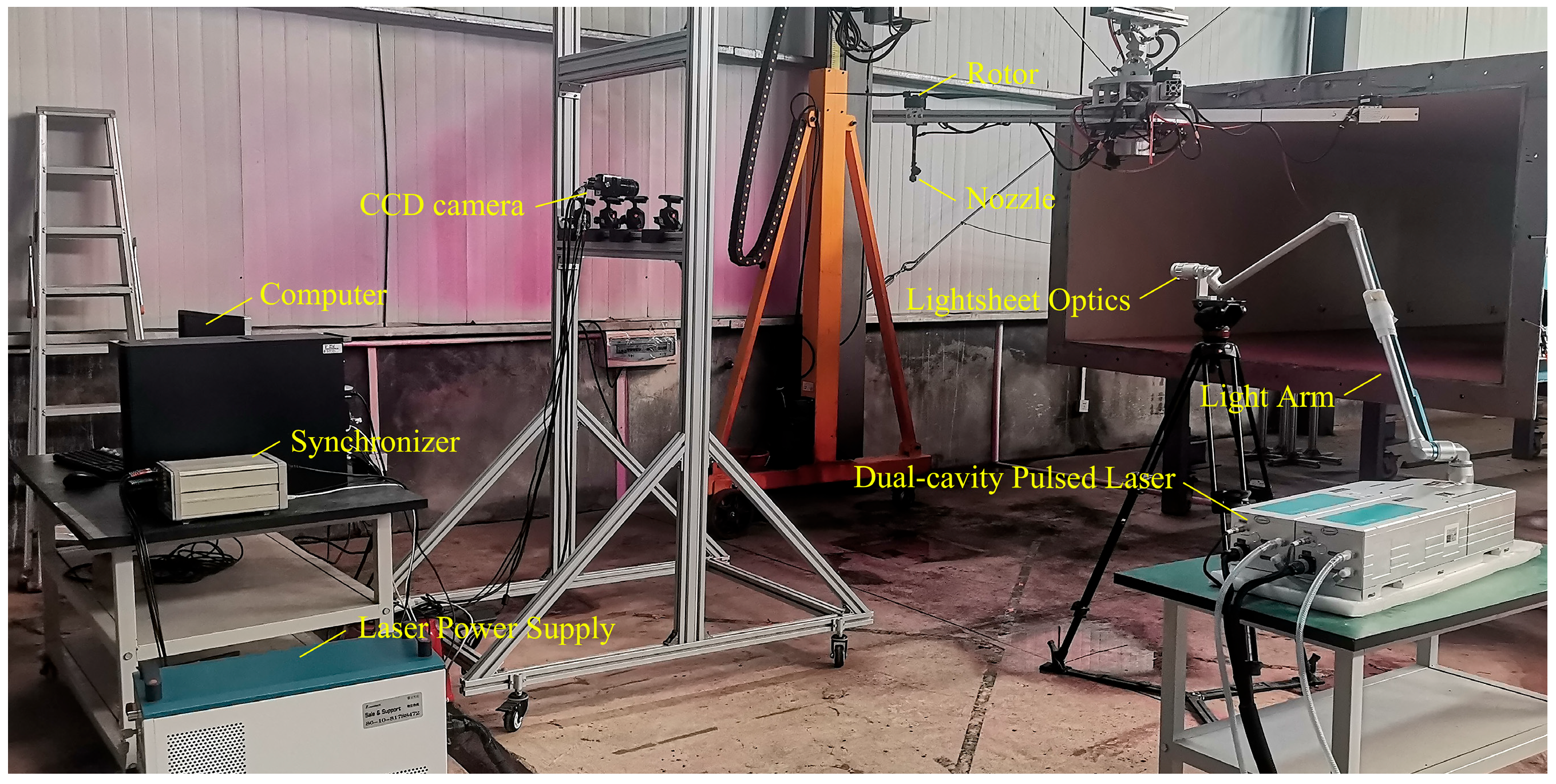
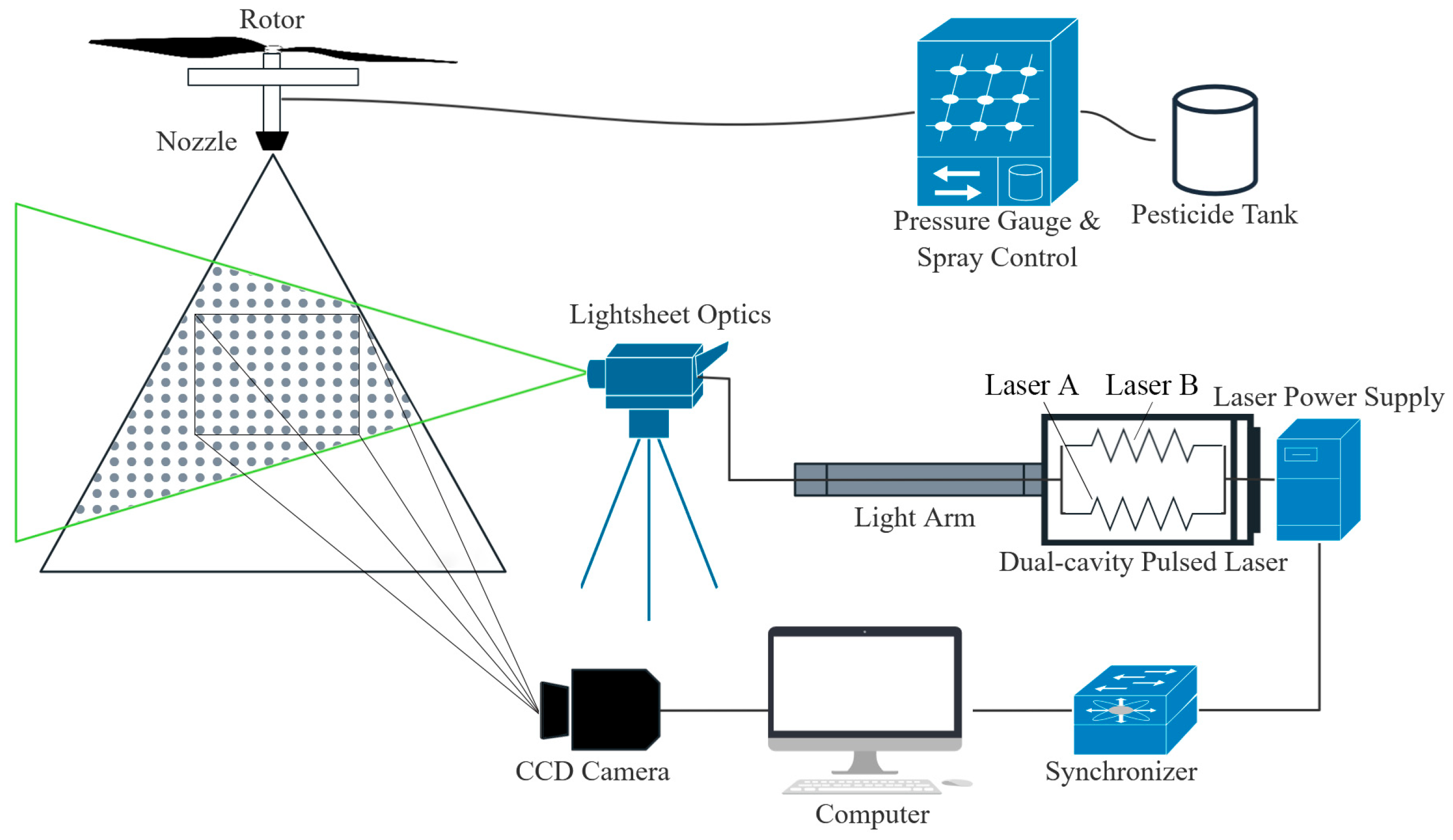

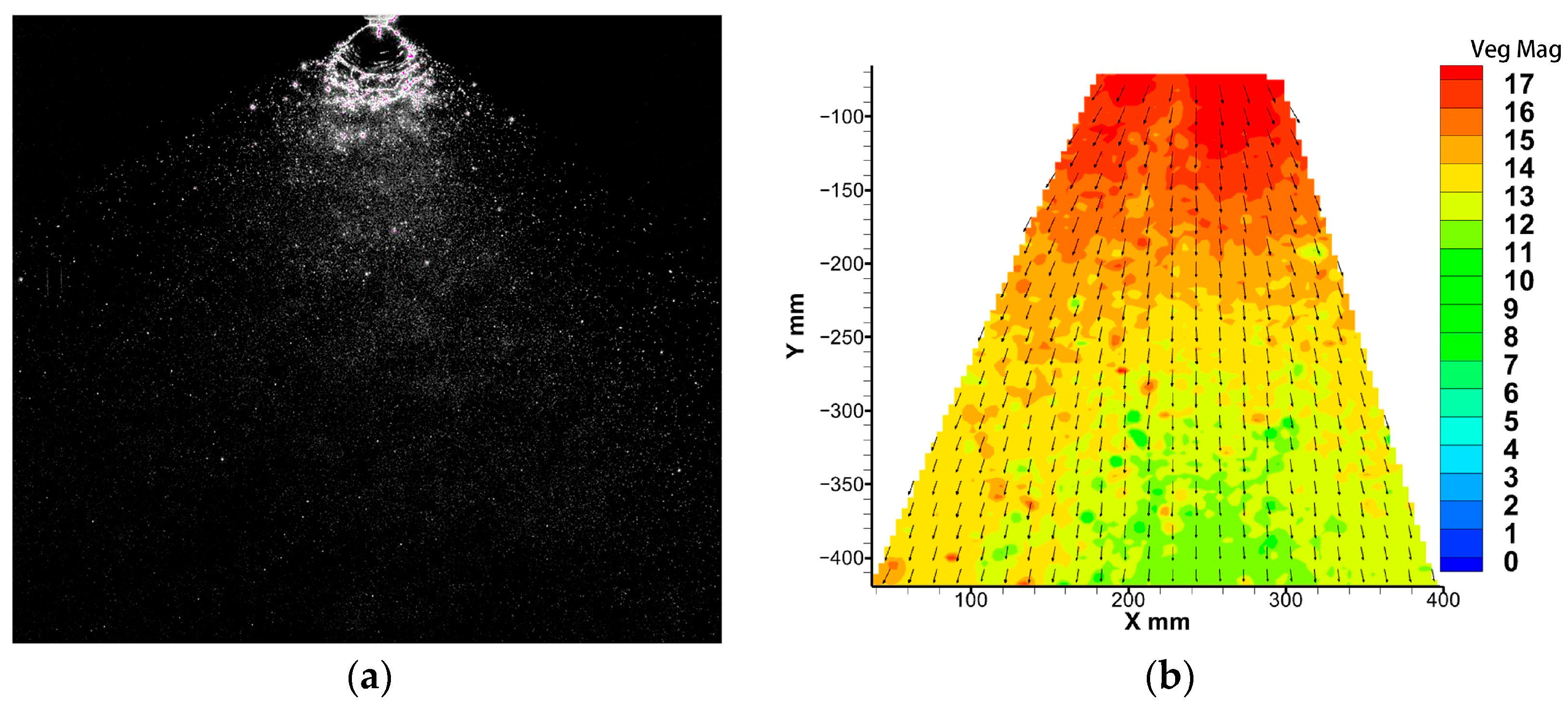
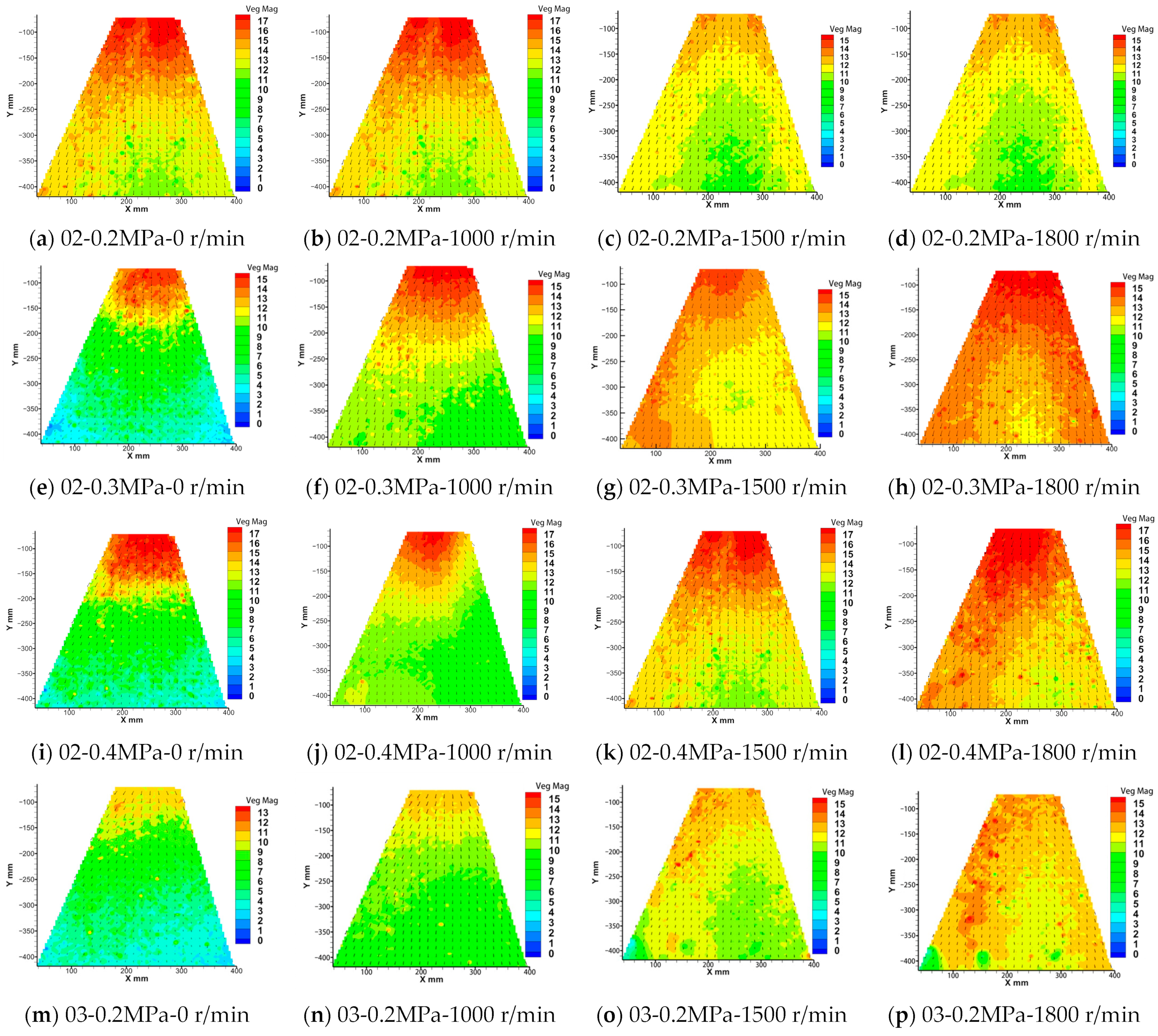
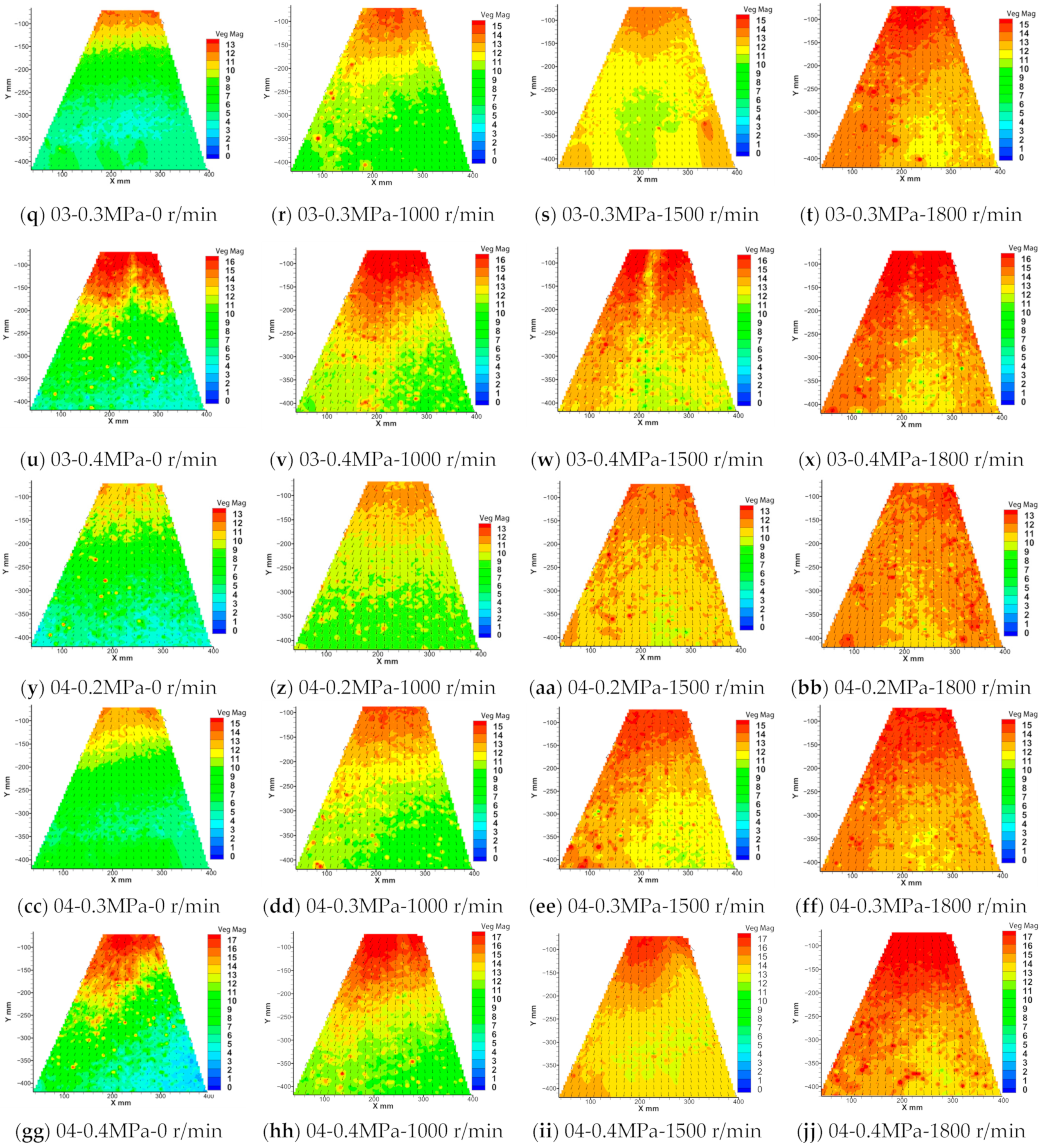

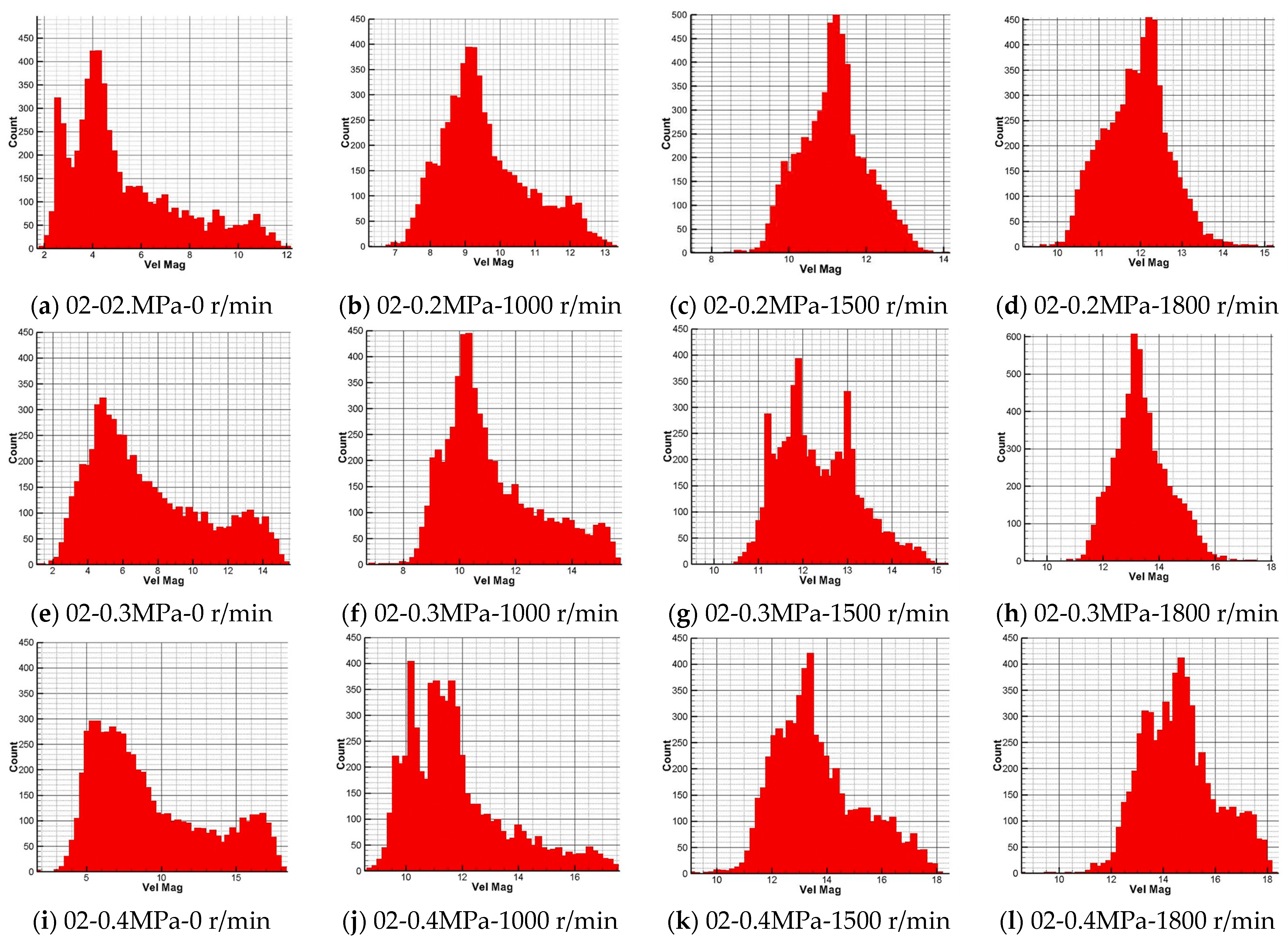



| Spray Pressure (Mpa) | Nozzle Type | Rotor Speed (r/min) |
|---|---|---|
| 0.2 | LU120-02 | 0 |
| 0.3 | LU120-03 | 1000 |
| 0.4 | LU120-04 | 1500 |
| 1800 |
| Spray Pressure (MPa) | Nozzle Type | Dv10/μm | Dv50/μm | Dv90/μm | RS |
|---|---|---|---|---|---|
| 0.2 | 02 | 67.91 (±1.53) | 134.36 (±1.74) | 278.72 (±2.90) | 1.57 (±0.014) |
| 03 | 74.8 (±1.95) | 163.45 (±1.27) | 334.22 (±3.72) | 1.59 (±0.026) | |
| 04 | 87.46 (±2.94) | 192.46 (±0.65) | 381.58 (±7.56) | 1.53 (±0.026) | |
| 0.3 | 02 | 66.16 (±1.32) | 127.62 (±0.63) | 269.55 (±4.78) | 1.59 (±0.039) |
| 03 | 65.77 (±0.74) | 129.22 (±1.93) | 266.27 (±4.40) | 1.55 (±0.028) | |
| 04 | 74.71 (±1.68) | 160.28 (±2.39) | 298.4 (±3.87) | 1.40 (±0.047) | |
| 0.4 | 02 | 71.07 (±0.77) | 121.81 (±0.97) | 202.42 (±1.61) | 1.08 (±0.012) |
| 03 | 63.64 (±1.05) | 122.72 (±1.63) | 272.22 (±3.41) | 1.70 (±0.051) | |
| 04 | 70.52 (±0.95) | 135.73 (±1.54) | 289.64 (±7.84) | 1.61 (±0.079) |
| Factor Name | Droplet Velocity (m/s) | Droplet Velocity Decay Rate (%) | ||||
|---|---|---|---|---|---|---|
| F-Value | p-Value | Significance | F-Value | p-Value | Significance | |
| Rotor Speed | 4.284 | 0.017 | * 1 | 3.407 | 0.039 | * |
| Rotor Speed * Nozzle Size | 1.149 | 0.354 | 1.606 | 0.220 | ||
| Rotor Speed * Spray Pressure | 1.052 | 0.392 | 0.193 | 0.900 | ||
| Spray Pressure * Nozzle Diameter * Rotor Speed | 1.283 | 0.307 | 1.152 | 0.353 | ||
Disclaimer/Publisher’s Note: The statements, opinions and data contained in all publications are solely those of the individual author(s) and contributor(s) and not of MDPI and/or the editor(s). MDPI and/or the editor(s) disclaim responsibility for any injury to people or property resulting from any ideas, methods, instructions or products referred to in the content. |
© 2024 by the authors. Licensee MDPI, Basel, Switzerland. This article is an open access article distributed under the terms and conditions of the Creative Commons Attribution (CC BY) license (https://creativecommons.org/licenses/by/4.0/).
Share and Cite
Hu, S.; Xu, X.; Liu, J.; Guo, J.; Guan, R.; Zhou, Z.; Lan, Y.; Chen, S. Movement Characteristics of Droplet Deposition in Flat Spray Nozzle for Agricultural UAVs. Agriculture 2024, 14, 1994. https://doi.org/10.3390/agriculture14111994
Hu S, Xu X, Liu J, Guo J, Guan R, Zhou Z, Lan Y, Chen S. Movement Characteristics of Droplet Deposition in Flat Spray Nozzle for Agricultural UAVs. Agriculture. 2024; 14(11):1994. https://doi.org/10.3390/agriculture14111994
Chicago/Turabian StyleHu, Shiyun, Xiaojie Xu, Junyu Liu, Jianzhou Guo, Runhong Guan, Zhiyan Zhou, Yubin Lan, and Shengde Chen. 2024. "Movement Characteristics of Droplet Deposition in Flat Spray Nozzle for Agricultural UAVs" Agriculture 14, no. 11: 1994. https://doi.org/10.3390/agriculture14111994
APA StyleHu, S., Xu, X., Liu, J., Guo, J., Guan, R., Zhou, Z., Lan, Y., & Chen, S. (2024). Movement Characteristics of Droplet Deposition in Flat Spray Nozzle for Agricultural UAVs. Agriculture, 14(11), 1994. https://doi.org/10.3390/agriculture14111994








